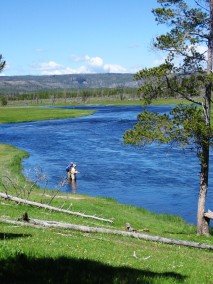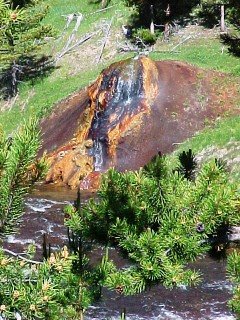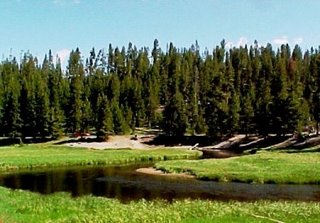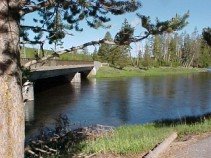fish hard the days are getting shorter
Some Small Secrets Revealed
less people -- more fish

<- Firehole River @ Ojo Caliente parking area.
-- With our summer in full swing, it's time to expand the offerings in the fly box. Any given day on the Yellowstone Plateau can bring forth weather of any given sort. The aquatic insects are sensitive to this, and sometimes inclement weather is your best chance for catching a hatch. THE FIRE HOLE RIVER is still fishing like a storybook river. It's just that, now, the stories have developed some plot twists.
-- The early morning hatches of Mayflies are combined with a spinner fall. Catching the "spinner float" requires an early breakfast and dedication to the proposition that someone has to catch all those fish that nobody ever sees. Use a generic Mayfly pattern, (we like the Yellowstone Morning Glory,) with a bit of the pattern that represents a trailing shuck, or downed wings. Sizes for the current hatch seem to be in the 16 - 20 range, so take a fist full of each.
-- Start fishing early enough to beat the crowds, (just after sunrise,) and fish until around 10:30 AM. The very soft currents and slower foam lines contain a lot of trout food, and the parking lot at Ojo Caliente is a good place to begin. We like to fish down on these early mornings, other early birds fish up. By the time you've worn out a stretch of water folks will be filling up the parking lot, and as you leave for a leisurely brunch you can tell them -- " . . . you should'a . . . . . "
-- The PMD's are still around, and on those blustery mornings you can look forward to finishing your morning with a flurry of Baetis. You might even bump into the mid-day Caddis. Should you choose to fish through lunch time a few well selected nymphs and small soft hackles will serve you well.
-- Evenings on the Firehole right now are showing good Caddis hatches - some are small. For the smallest dark gray or black Caddis, we like a Deer Hair Caddis pattern with a dark body originated by Jason Neuswanger at The Trout Nut. Right now sizes 18 - 20 seem about right.

<- Find This Place For Fish
-- We've been spending quite some time on the Gibbon River in our annual, (still unsuccessful,) Grayling quest, and have taken many good fish and just piles of Brook Trout. The mornings are filled with wet fly and soft hackle work. Occasionally we throw some Stiff Hackle Nymphs if the clouds are low.
-- The hot spring shown above is across the Gibbon River from a nice big parking lot in the canyon section. The walls of the canyon are mostly too steep for mature fisherfolk, but there is a trail that will get you down to the river. There are always good fish in this steep riffle section, and it is seldom fished. We took a nice Brown Trout of 14" here and recommend this place for the more fit fisherfolks.
-- The National Park Meadow section of the Gibbon River has slowed to seasonal levels and inspection of the clear water shows that the scoured sandy bottom is almost devoid of vegetation. This varies from year to year, and when it is in this condition fishing becomes too challenging for most folks. The fish are of generous proportions but hold in plain sight in undercuts. This requires getting some grass stains on your waders. Caddis in the late evening is your best bet.

<-- Campground Pool on the Gibbon River
-- At Norris, Dusty took a Grayling in the "Campground Pool" on a size 14 soft hackle with an olive body. He was elated, we were dejected. The open dirt bank in the left center mid-ground is above the pool where the Grayling was fooled. He crawled across all that grass on his knees. That's him at the point. He had to release a dozen Brook Trout before his triumph.
-- The thin water of this upper section is very clear now, and pending rains will stay that way for the summer. Hatches are also thin and localized. Be prepared to scare a lot of fish unless you are gentle in your approach. The Elk Meadow, and Gibbon Meadow sections are still guarded by bison. Evening Caddis hatches are producing good numbers of both Brown and Rainbow Trout. There are some good sized Whitefish in this section too. We saw a 15" whitefish that was as thick as a Foster's Oil Can.
-- Nez Perce Creek above the story board is still fishing good, and there are some PMD's coming off as late as 1:30 PM. Be careful as you work the second or third meadow. The ground is still soft and the bison are filling up the lush green landscape. Most fish taken in this section will be fooled with a small Wooly Bugger with an olive or dark gray body. In the evening you can float a size 16 Wolly Bugger, or an Elk Hair Caddis to the fish.
-- This piece of water is often overlooked by both visitors and locals alike. We're sorry for them and pleased to enjoy the solitude. Soon the day hikers and backpackers will fill the trails but the fisherfolks are not often seen. Catching is steady along this bit of Nez Perce Creek but not as furious as it can be on the glory waters.

<-- Seven Mile Bridge at Gneiss Creek Trailhead.
-- On the Madison River there are several hatches that can be fished if you find them. The local trout shops can give you a location on a daily - or hourly basis. One bit of water that is neglected is the 1/2 mile below seven mile bridge. Most people fish this section from the rest stop, or the pullouts adjacent to the road.
-- The parking lot at the Gneiss Creek Trailhead allows access to an excellent bit of water. Start with some long roll casts to the bridge footings. A good sized Bead Head Hare's Ear, (6 - 10,) with proper placement will start you off on the right foot. If you fish the river from the road side you will meet many local folks and may get a truthful tip or two.
-- There are some small yellow stoneflies in this section and herds of caddis in the late evening. Depending on the day the Gray Drakes may appear here first. If bison are encountered on the trail above your head as you fish downstream, be sure not to hook one with your backcast: most tippets just will not hold.
-- We have some reports that both the Lewis River and Lewis Lake, in the southern part of the park, are beginning to attract fisherfolk. For current information about these locations visit Jack Dennis or his web site. There is also a stirring on the Gallatin River. We braved the willows a couple of weeks ago and took a small fish. The water is still cold, and bug activity is just starting.
-- A tip for the more adventurous. Ask a local fly shop about Slate Creek. Right now the Brook Trout are going nuts. They are starved. Some are 11" long but most are 5" - 10". There are days on this little stream when you can get tired of catching fish. There are days when you are driven out of the water by the fry eating your waders. It's worth the walk; so too is Greebe Lake, if you have a Grayling fixation -- no names mentioned.
JENNY, Call your mom.